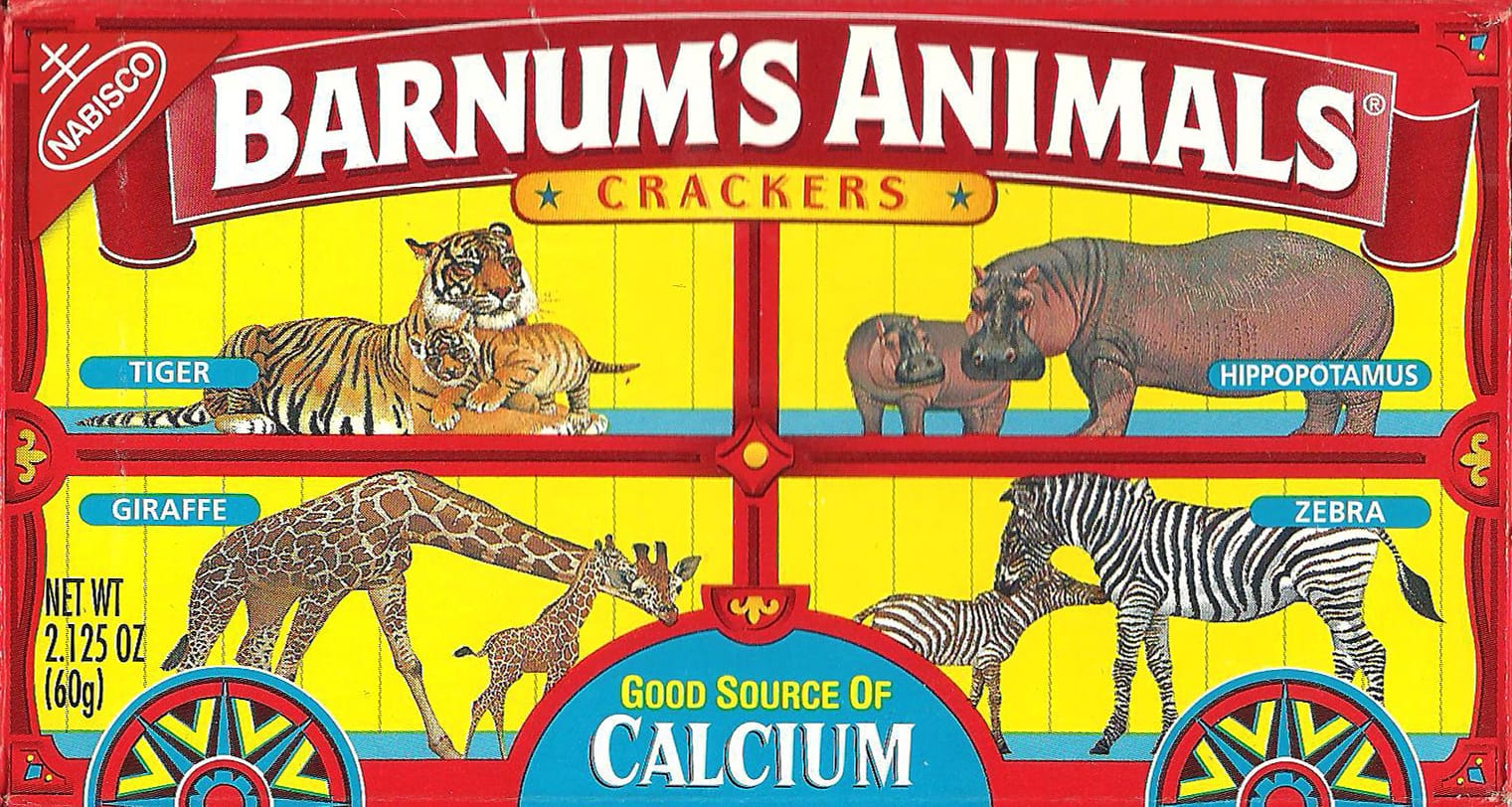A Century of Crunchy Critters: The Story of Barnum’s Animal Crackers
Barnum’s Animal Crackers—those bite-sized biscuits shaped like zoo animals—have captivated snackers for over a century. Their story, however, extends far beyond childhood nostalgia, encompassing circus lore, evolving social values, and even a touch of controversy. Let’s embark on a journey through time, exploring how these crunchy treats became a cultural icon.
Under the Big Top: The Early Years of Barnum’s Animals
In 1902, the National Biscuit Company (Nabisco) introduced “Barnum’s Animals,” a tribute to the legendary showman P.T. Barnum and his famed circus. While the exact composition of the first box remains a mystery, it likely included classic favorites like bears, elephants, and tigers. Over time, the menagerie expanded to a remarkable 53 different animal shapes, reflecting our ever-changing fascination with the animal kingdom. This early connection to the circus likely contributed to the crackers’ initial popularity, associating them with the excitement and wonder of the big top. Learn more about Aiken Rhett Charleston SC, a historic site that similarly captures the spirit of a bygone era.
“Animal Crackers in My Soup”: Shirley Temple and a Snack Sensation
In 1935, Barnum’s Animal Crackers reached new heights of popularity, thanks to Shirley Temple’s infectious tune, “Animal Crackers in My Soup.” Interestingly, the song mentions rabbits, despite their absence from the cracker lineup. This lyrical quirk adds to the song’s charm and highlights the power of imagination. Nabisco capitalized on the song’s success, incorporating it into their advertising, further solidifying the crackers’ place in American culture. This suggests that popular culture can significantly influence a product’s trajectory.
From Circus Tent to Shopping Cart: The Enduring Appeal
Today, over 40 million boxes of Barnum’s Animal Crackers are sold annually. While many beloved animal shapes remain, Nabisco has introduced new packaging and limited-edition assortments to maintain consumer interest. This enduring popularity speaks to the crackers’ timeless appeal, transcending generations. The continuous adaptation of packaging and product offerings likely contributes to their sustained success in a competitive market.
Beyond the Bite: Unraveling the Mysteries
Barnum’s Animal Crackers’ history presents several intriguing questions:
- The Mystery of the Vanishing Animals: Why have some animal shapes been retired? Some experts believe it may reflect changes in conservation awareness, popular culture trends, or production costs.
- The Rabbit Riddle: Why did Shirley Temple sing about rabbits that never existed in cracker form? Was it an oversight, creative license, or a hint at a forgotten cracker?
- Cardboard Jungle Collectibles: Vintage Barnum’s Animal Crackers boxes and memorabilia are now sought-after collectibles, suggesting a nostalgic appreciation for the brand’s history.
- Culinary Creativity: Animal Crackers have found their way into various recipes, from cheesecake crusts to ice cream toppings, demonstrating their versatility beyond snacking.
These unanswered questions and creative uses add further depth to the story of Barnum’s Animal Crackers, transforming them from a simple treat into a cultural artifact.
The Great Animal Cracker Escape: How Barnum’s Animals Broke Free
In 2018, after 116 years, Barnum’s Animal Crackers underwent a significant transformation. The animals, once depicted in cages on the box, were liberated, now roaming free in a vibrant savanna. This dramatic shift wasn’t arbitrary; it reflected evolving social attitudes towards animal captivity, particularly in circuses.
This “Great Escape” was largely driven by PETA’s advocacy. Their campaign, combined with growing public concern about animal welfare, likely spurred Mondelez (Nabisco’s parent company) to redesign the packaging. The new box, showcasing a diverse array of animals in a natural habitat, symbolized a more compassionate perspective. This redesign highlights the power of consumer activism and corporate responsiveness to social change.
| Feature | Old Packaging | New Packaging |
|---|---|---|
| Animal Depiction | Animals in cages, resembling a circus train | Animals roaming free in a savanna setting |
| Symbolism | Captivity, entertainment | Freedom, natural habitat |
| Social Context | Reflects historical acceptance of animal captivity in entertainment | Reflects contemporary concerns about animal welfare |
This change sparked considerable discussion. While some applauded the move, others expressed nostalgia for the original design. This diverse reaction underscores how even a simple cracker box can become a lightning rod for broader cultural conversations. It also demonstrates the complexities of balancing tradition with evolving ethical considerations.
The Secret History of the Barnum’s Animal Crackers String
In 1902, Barnum’s Animal Crackers boxes came with a string attached—not for practical use, but for a festive purpose, specifically during the Christmas season. The string allowed consumers to hang the empty boxes on their Christmas trees, transforming them into ornaments. This resourceful practice, reflecting the values of the era, gave the boxes a second life. This unique feature likely boosted sales, offering a treat that doubled as a decoration.
This dual-purpose packaging speaks to a time when resourcefulness and reducing waste were commonplace. The string, however seemingly insignificant, represented added value and a touch of holiday magic. The string’s eventual disappearance may be attributed to shifting consumer habits and the rise of disposable packaging. While the exact date of its removal remains unknown, its absence is a nostalgic reminder of a different era. This shift in packaging practices suggests a move away from reusability and towards convenience, reflecting changes in consumer behavior and manufacturing processes.
How Old Are Animal Crackers? Unearthing the Legacy of Barnum’s Beloved Treat
Barnum’s Animal Crackers have graced pantries for over 120 years. Introduced around 1902 as “Barnum’s Animals,” the name officially changed to “Barnum’s Animal Crackers” in 1948. This longevity is a testament to their enduring appeal as a classic American snack. Over 40 million packages are sold annually, a remarkable feat in a constantly evolving market. The fact that these crackers are still produced in Fair Lawn, New Jersey, using a massive 300-foot-long oven, speaks to the enduring appeal of this classic treat.
Initially leveraging the fame of P.T. Barnum’s circus, the crackers featured iconic animals like lions, tigers, bears, and elephants. Over time, more than 37 different animal shapes have appeared in Barnum’s Animal Cracker boxes. In 1958, production methods were modernized, leading to more detailed animal shapes, demonstrating Nabisco’s commitment to innovation.
The continued popularity of Barnum’s Animal Crackers suggests that their simple pleasure transcends generations, solidifying their position as a timeless treat. The evolution of their production and the variety of animal shapes likely contribute to their sustained market success. While the future of Barnum’s Animal Crackers remains to be written, their rich history and enduring popularity suggest that they will likely continue to be a beloved treat for years to come.
- Georgia Platform: A Southern Strategy, 1850s - March 31, 2025
- How many weeks is 40 days: Quick Conversion Guide for Accurate Results - March 31, 2025
- How many feet is 300 meters? 984 Feet: Understand Length Conversions Easily - March 31, 2025

















2 thoughts on “Barnum’s Animal Crackers: A Wild History of Circus Treats and Crunchy Controversies”
Comments are closed.